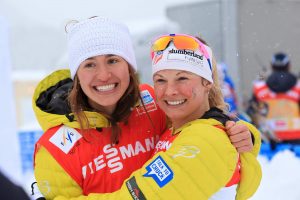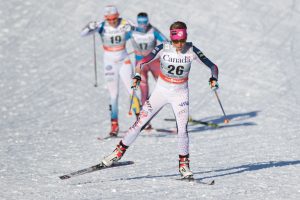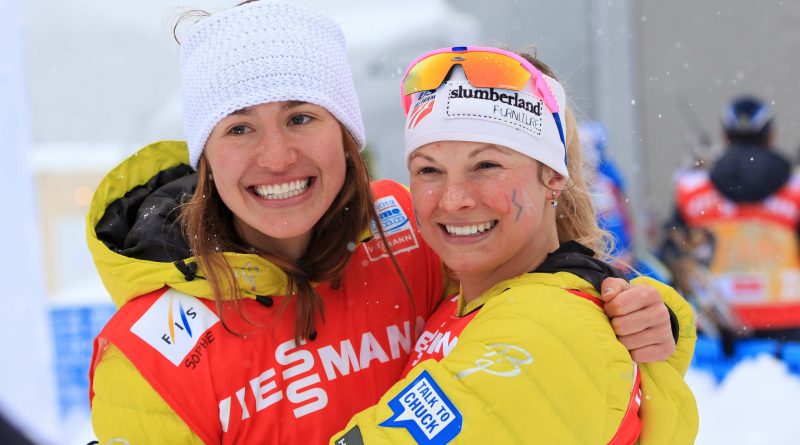How The Women’s Nordic Team Got to Gold
More than half of the U.S. Cross Country Team in PyeongChang is either from Vermont or trains here. And here’s why we knew these women would medal. By Peggy Shinn
On any given day this past summer, you might have come across a group of sculpted athletes roller-skiing along a quiet road. Come winter, you might have caught an occasional glimpse of them skating at a break-neck pace at the Craftsbury Outdoor Center or the Stratton Nordic Center.
And there is a very good chance that come February, you may see at least one of them standing on the podium at the Olympics. (To see who made it, click here.)
Of the twelve cross-country skiers on this year’s national team, seven are either from Vermont or train here.
Burke Mountain Academy grads and northern Vermont locals, Liz Stephen and Ida Sargent are strongholds on the team. Farther south, Stratton Mountain School’s Sverre Caldwell has put together a powerhouse of a training team that includes his daughter Sophie Caldwell, her cousin Paddy and four-time Olympian Andy Newell of Shaftsbury. Caldwell’s Stratton Mountain School Elite Team, as it’s now called (supported for several years by the T2 Foundation for promising ski racers), has also lured to Vermont the likes of Jessie Diggins from Minnesota and Simi Hamilton from Colorado.
“It’s one of the strongest teams we’ve ever had,” says Tom Kelly of U.S. Ski & Snowboard. “And you’ll see most of them competing at PyeongChang.”
From Solo Stars to an A-Team
The story of how that team came to be, and of the women’s team in particular, is one of the great backstories of the 2018 Olympics.
It started with the women’s team, nearly twenty years ago, when Kikkan Randall, a young alpine skier and runner from Alaska, decided to switch her focus to cross-country skiing. The niece of two Olympic cross-country skiers, Randall laid out a 10-year plan to win an Olympic medal. That has since become a 19-year plan that’s carrying Randall, now 35, into her fifth Olympics.
Randall knew that if she wanted to reach her goals, she needed others to help. She had witnessed how teammates push each other and can make the process more fun—if done correctly. She openly welcomed competition and wanted other women to join her on the team.
Matt Whitcomb, a Stratton Mountain School grad from western Massachusetts, was thinking the same thing. After graduating from Middlebury College in 2001, he began coaching at Burke Mountain Academy. There, he caught the attention of U.S. head cross-country coach Pete Vordenberg.
Whitcomb had a good vibe with the kids, and the Burke cross-country skiers looked like they were loving the sport. Of all the cross-country ski teams that Vordenberg had seen across the United States, he was struck by the Burkies’ camaraderie. This was what the U.S. team needed. Whitcomb was hired by the team in 2006 and became the women’s head coach in 2011.
In November 2011, Whitcomb brought three other women on the full World Cup tour: 2010 Olympians Holly Brooks and Montpelier’s Liz Stephen, and Orleans’ Ida Sargent, a Dartmouth College student and Craftsbury skier.

Then, in January 2012, Minnesotan Jessie Diggins joined them. Now, with five women competing in Europe, the Americans could field a relay team, even if the best they had finished to date was ninth.
The relay, Whitcomb always said, was the true test of a team’s success. To win, or even make it into the medals, required four talented skiers—not just one—to keep the team out front. In the Americans’ case, they had yet to show this depth.
The turning point came in 2012. The team’s chances had looked especially dismal for a World Cup relay the previous season. In mid-February 2012, a World Cup stop in Nové Mesto in the Czech Republic featured a 15 km event in the classic technique on the first day, then a relay the following day—4 x 5 km for the women, 4 x 10 km for the men. With Randall on the sidelines nursing a cold and the entire team fatigued after the brutal 15 km race, where none of them had finished in the top 30, it looked like the team would again finish somewhere near the back in a World Cup relay.
Rather than grimly accepting their fate, on the morning of the relay Brooks, Sargent, Stephen, and Diggins cranked up the music, applied face paint and glitter to their cheeks, and pulled on red, white, and blue striped socks over the legs of their speed suits. Randall had picked up four pairs of these striped socks at a German convenience store earlier in the season, thinking they might help stir up some good ol’ U-S-A team spirit.
As the U.S. women warmed up for the relay, the other teams looked at them as if they had lost their minds. Who were these clowns with paint on their faces and crazy socks on their feet?
On the course, the four American women were all business. With Diggins cheering from the sidelines, the women ended up finishing fifth in the Nové Mesto relay, the best finish by a U.S. women’s team in a World Cup relay to date. And Diggins skied the fastest freestyle leg that day—even faster than Olympic champion Charlotte Kalla from Sweden. Five months later the team earned its first podium.
After that breakthrough season, the U.S. women began racking up more medals, more trophies, and more titles. When Randall and her teammates took to the start line in glitter, face paint, and funny socks, their reserved European competitors no longer thought that the Americans were crazy.
There was something about this American team that was working, and their sense of camaraderie rubbed off on their competition. The entire World Cup tour started to feel more like a family, where people began to realize that they could be both friends and competitors.
The women figured out how to bring the best of themselves to this American team, and created an environment where they felt at home, even when they were on the road for almost half of each year. They were inherently optimistic and happy for each other. As Whitcomb liked to say, “You don’t have to be best friends with everyone on the team, but you have to be best teammates.”

Photo © Reese Brown
The Season to Peak
Now, going into PyeongChang, all seven women on the U.S. A and B teams have earned at least one World Cup podium finish. This season alone, an American has finished on the podium in every major sprint race: Sadie Bjornsen, 28, finished second and third, respectively, in the first two sprints (both in the classic discipline), and Randall—now 35 and back from the birth of her son in April 2016—finished third in the final sprint (freestyle) before the holiday break. In that same race, Diggins and Sargent also made the final (top six).
In mid-December, Sophie Caldwell and Ida Sargent traveled to Austria for an Alpen Cup sprint (the Alpen Cup is the World Cup’s “minor league”). There, Caldwell beat Russian Natalie Matveeva—a four-time World Cup winner—for the win, and Sargent finished right behind in third.
As the team, still in Europe, took a break from racing this December, they each took turns on the SMS T2 blog. Diggins wrote:
“I’m looking forward to a chance to have a little mental break from the intensity that is World Cup racing and do some holiday COOKIE BAKING!
I’m staying with Liz and Andy in a cottage in Seefeld, Austria, and Paddy and his family, Pat and Ida, as well as Simi and Sophie are also staying nearby so it’s going to be an awesome team atmosphere.
Besides training hard and racing our brains out, we’ve found time for some other fun. The guys are all extreme cribbage pros by now, since they play an average of 3 games a day.
I’ve been teaching dance class to the team for the past few weeks for our latest team music video cover, so we had a lot of laughs filming that!”
The team is, in many ways a family — both literally and figuratively. Paddy and Sophie Caldwell are cousins. Sophie dates Simi Hamilton and Andy Newell is married to SMS teammate Erika Flowers.
But most of all, there’s a sisterhood on the women’s team that drives them.
The women have learned to focus on the positives and help each other through the negatives of careers in a sport that garners few headlines in the United States. It’s a sport where they really could view the glass as half empty—having had to overcome funding issues and injuries and illnesses in a brutally hard sport in which it takes decades to develop, and to compete against countries where doping has been rampant. But these women perpetually see the glass as half full. Through many ups and downs, they have had one goal in mind—to win an Olympic medal, especially in the team relay.
But should they fall short of this goal, they know that the journey of creating this team has been worth it. It’s a dynamic that we all could learn from.


Pingback: These 10 XC Skiers from VT are Headed to the Olympics - VT SKI + RIDE
Pingback: You Olympic News, All In One Place — VT SKI + RIDE Magazine
Pingback: Don't Miss These 6 Events - Vermont Sports Magazine